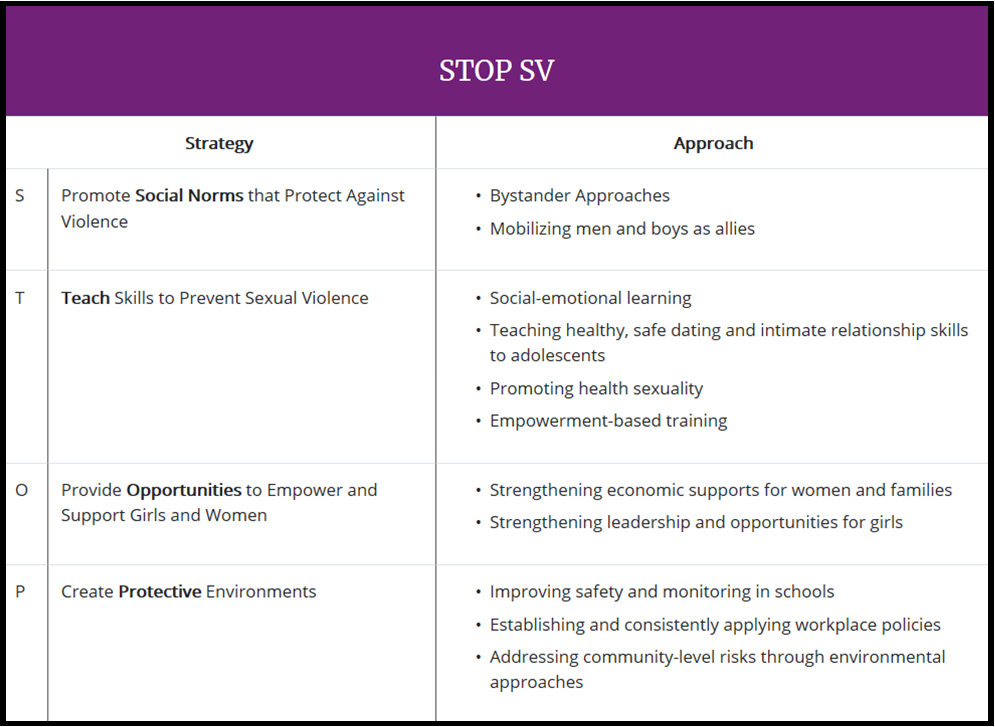Sexual Violence/Rape Prevention and Education Program
What is sexual violence?
The Centers for Disease Control and Prevention (CDC) defines sexual violence as sexual activity without obtaining consent, consent given freely, or with someone unable to consent or refuse, including "rape" or "sexual assault." This type of violence can be committed by a friend, intimate partner, coworker, neighbor, or family member. It includes: forced or alcohol/drug facilitated penetration of a victim, forced or alcohol/drug facilitated incidents in which the victim was made to penetrate a perpetrator or someone else, non- physically pressured unwanted penetration, intentional sexual touching, or non-contact acts of a sexual nature. Sexual violence can also occur when a perpetrator forces or coerces a victim to engage in sexual acts with a third party.
The consequences of sexual violence, have a range of implications including physical, psychological, depression, anxiety, and suicidal thoughts. Chronic issues may arise, such as post-traumatic stress disorder, sexual health problems, negative health behaviors (e.g., smoking, abusing alcohol/drugs, risky sexual activity). A person's economic wellbeing (e.g., employment, work performance) can also suffer due to sexual violence. These health and economic consequences affect individuals, communities, and society overall, making it a significant public health issue to address.
In California, more than 1 in 3 women and 1 in 4 men report experience sexual violence involving physical contact in their lifetime. Nationally, an estimated 23 million women have experienced completed or attempted rape in their lifetime1. This does not encompass how significant the problem is with many occurrences of sexual violence going unreported. The estimated cost per rape victim is $122,461 over their lifetime2. In 2012, tangible costs such as medical and health costs added up to over $9 billion. When considering intangible costs such as lost productivity, the cost increases to $140 billion making it a serious public health concern3.
The CDPH Injury Violence and Prevention Branch (IVPB) works to change attitudes, behaviors, and social conditions that make sexual violence possible in the first place. IVPB utilizes public health strategies and a primary prevention approach, through guidance provided by the CDC4. IVPB uses prevention strategies such as promoting social norms that protect against violence, teach skills to prevent sexual violence, provide opportunities to empower women and girls, and create protective environments5.
CDPH's Role in Violence Prevention
The Injury Violence and Prevention Branch's (IVPB) violence prevention programs address domestic violence (DV), teen dating violence (TDV), and sexual violence (SV) through shifting social norms, policies, and practices. Programs use a primary prevention approach, which promote healthy behaviors and environments to stop violence before it even occurs. Rather than focusing on individuals and victims, IVPB's programs work at a broader population level as opposed to providing direct services to victims after the violence has occurred. For more information and resources about CDPH's public health approach to violence, visit the CDPH Violence Prevention Initiative.
Rape Prevention and Education Program (RPE)
Mission
To prevent first-time
victimization and perpetration of sexual violence, rather than helping people
who have already been victimized.
Program Description
CDPH IVPB administers RPE funds, through a population-based allocation to each state by the CDC, to local rape crisis centers across the state. All local rape crisis centers in California are eligible for RPE funds and awards are provided through a competitive bid process. CDPH also supports evaluation and technical assistance and training for local rape crisis center through its partners.
Currently CDPH funds local rape crisis centers (PDF) that implement primary prevention strategies across the individual, relationship, community and societal levels within their local communities and populations in need. Prevention strategies include community mobilization, gender equity, active bystander, and healthy relationships in community-based or school-based settings. CDPH's strategies promote programs, policies, and practices that align with the CDC focus areas and approaches in creating protective environments, promoting social norms, teaching skills, and empowering girls and women.
The table below, published within the CDC's Stop SV: A Technical Package to Prevent Sexual Violence 2016, provides a comprehensive list of recommended evidenced-based and evidenced-informed approaches to the primary prevention of sexual violence.
